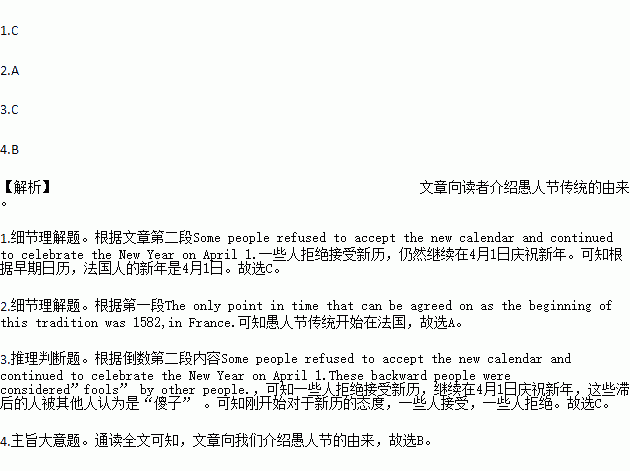题目内容
Unlike most other holidays,the history of April Fools’ Day.Sometimes called All Fools’ Day,is not totally clear.The only point in time that can be agreed on as the beginning of this tradition was 1582,in France.Before that year,the New Year was celebrated for eight days,beginning on March 25.The celebration reached the highest point on April 1.With the reform of the calendar under Charles 1X,the the Gregorian calendar(公历,阳历)was introduced,and New Year’s Day was moved to January 1.
However,because in those days communications were not as developed as they are today,many people did not receive the news for several years.Some people refused to accept the new calendar and continued to celebrate the New Year on April 1.These backward people were considered”fools” by other people.They were often sent on “fools” errands(徒劳无益的工作)or were made the targets of jokes.
This developed,over time,into a tradition of playing a trick on someone on the first day of April.The tradition eventually spread to England and Scotland in the eighteenth century.It was later introduced to the American colonies of both the Britain and France.April Fools’ Day thus developed into an international fun feast,so to speak,with different nationalities specializing in their own kind of humor at the expense of their friends and families.
1.According to an earlier calendar,New Year’s Day in France was .
A. March25 B. January 1 C. April 1 D. April3
2.Which of the following first had the tradition of celebrating the April Fools’ Day?
A. France. B. England. C. Scotland. D. America.
3.What was people’s attitude towards the new calendar?
A. They accepted it happily. B. They refused it immediately. C. Some recognized it. D. Some laughed at it.
4.The passage mainly tells us .
A. what the French did on April Fools’ Day B. How April Fools’ Day come into being
C. when was the new calendar introduced D. why some people were fooled in France

